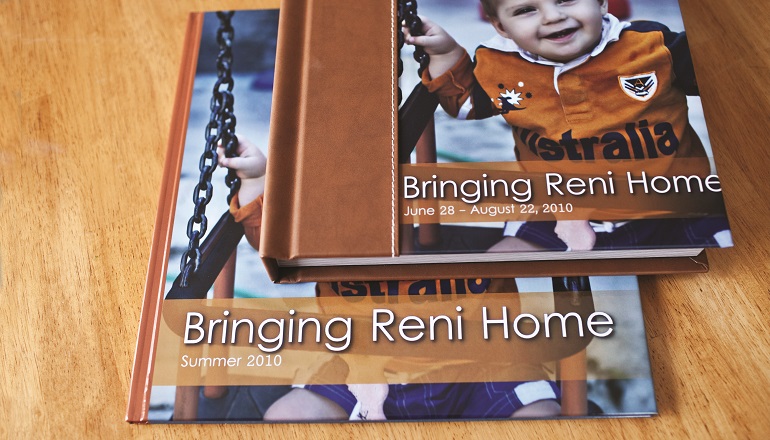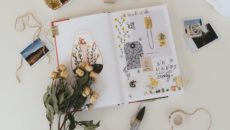When Ann Y. received her adoption referral, she knew she wanted to create something special with her new daughter’s photos during the wait for her to come home. The California mom had always been creative, enjoying photography and journaling.
“I felt I had to do something with them, to incorporate them into my life,” Ann explains. So began her scrapbooking obsession: first, a 10-page album, with the referral photos of Katie mixed with pictures of Ann and her husband filling out forms, waiting in line at the immigration office, and smiling as the guests of honor at a baby shower. “I wanted Katie to get an idea of what it was like before she came home,” Ann says.
As Katie’s homecoming neared, Ann realized that working on a paper scrapbook–with supplies strewn across the living room floor for weeks–wouldn’t be practical with a child wandering around. “But digital scrapbooking never appealed to me,” she says, until one night, after chatting online until 3 A.M. with a fellow adoptive mom and scrapbooker, Ann decided to give digital a try. “From that moment on, I was hooked.”
And she’s not the only one. The consummate “mom craft” has dived headfirst into the 21st century–and our families are at the head of the pack. Adoptive parents are creating digital parent profiles for expectant mothers, lifebooks, welcome home books, heritage scrapbooks, and travel books–all of which can be shared online, via e-mail, or in print.
Internet sites are popping up everywhere to meet the needs of digiscrappers, who have forgone scissors, glue, paper–and paper cuts–and the tedium of traditional scrapbooking for the ease and economy of a digital version. And while it’s true that digital scrapbooks don’t have textured papers and objects that give them a three-dimensional feel, you can achieve a convincing illusion of texture with digital effects, such as shadowing, notes Katie Bodiford, mom to Daniel, adopted from Russia.
If you’ve got a computer and the urge to create, you’re almost set. Here’s what you need to get started.
Photo Editing Software
Whether you take photos with a digital camera or scan prints, an integral part of the layout process involves editing your photos. Let’s face it–as much as you love Uncle Eddie, the sight of him talking with a mouthful of food, oblivious to your camera, can distract from even the cutest picture of your child.
For complete freedom to crop any unwanted element–like Uncle Eddie–out of the picture, scrapbookers recommend digital imaging software, like Adobe Photoshop Elements or Corel Paintshop Pro. The cost of the programs varies widely, from $20 to well into the hundreds, depending on the sophistication of the one you choose.
You can also use free programs that you download from or use on the Web, such as Shutterfly, Picasa, or GIMP, though their editing options may be more limited (you may have to forego adjusting color balance, for example). When choosing editing software, consider its layout capabilities. Often, the software will have functions you can use for page layout, as well.
Publishing Program
Just like the paper version, digital page layouts are created by layering backgrounds, photos, mementos, and embellishments on top of each other. Scrapbookers have several options to choose from:
Scrapbook-specific software: These programs–such as Scrapbook Factory Deluxe, My Memories Suite, Craft Artist Platinum, Smilebox–are available in stores and online, usually costing less than $40. The easy-to-learn programs use drag-and-drop technology to create layouts. Most come with lots of options for backgrounds, graphics, and fonts, and offer step-by-step tutorials.
- Web-based photobook tools: These sites allow users to create custom photobooks with images and text, then order a professionally bound soft- or hardcover volume. “I used Picaboo to create a lifebook for our daughter. I included photos from our adoption trip, her orphanage, and her caregivers. Their software allows you to customize nearly every element on each page, so it was easy to personalize her lifebook,” says Elizabeth Murray, who adopted from China. Other popular options are Blurb, Shutterfly, and MyPublisher.
- Software you already have: Even Microsoft Word and PowerPoint can be used to create a layout from scratch. Just ask Vicki Taylor, who used PowerPoint to create a scrapbook for expectant mothers. After she had spent months on a paper scrapbook, which Taylor gave to her agency, her adoption lawyer called and wanted one, too. “At this point I wasn’t ready to reinvent the wheel,” Taylor says. She created a PowerPoint scrapbook that could be printed or e-mailed to expectant mothers who were considering Taylor and her husband.
Adding Creative Elements
A number of sites sell inexpensive packages of high-resolution images that you can use to decorate your pages–and some graphic designers even give them away. As the population of adoptive digiscrappers grows, so does the selection of adoption-related images and kits, including country-specific ones for parents of kids from Asia, Eastern Europe, or Latin America; scrapandtell.com has a great selection of these kits. Find inspiration, tutorials, and free or inexpensive layouts and page elements on the blog thedailydigi.com.
If you think you might want to create more than one album, good news: Digital images can be modified and reused as many times as you’d like to use them. “That’s the beauty of digital scrapbooking,” explains Kim Ruettgers, mom to Ethan and Isabella, both adopted from South Korea. The terms of use may vary–for example, certain graphic designers restrict what their images may be used for–but once you download an image, its color, size, and special effects are up to you to change.
Want to include images of official documents, mementos, or art that’s not digital? A scanner is what you need. “I have scanned my daughter’s passport, country stamps, money, and other fun stuff,” says Nicki McGuill, mom to Aliya, born in Kazakhstan. McGuill reminds scrappers that it’s important to make sure there are no copyright restrictions on the paper items you use.
Sharing Your Scrapbook
Once your masterpiece is done, you’ll want to share it with the world. Pages created with publishing software can be saved as jpgs, gifs, or any kind of photo extension, and e-mailed as an attachment or uploaded to a website. No matter what program you use, you can also save layouts as PDF files and e-mail them, says Katie Bodiford.
Given a scrapbook’s sentimental value, you may also want something tangible, that your child can keep forever. In that case, print your pages. Here are three options for printing:
- Your own printer: You can print pages yourself, as long as your printer allows you to use card stock or photo-quality paper. (Check your printer manual for details.)
- Print shop: Independent printers, such as FedEx Office, can print pages for you.
- Online scrapbooking or publishing sites: Online photo sites, such as Shutterfly or Picaboo, will print and bind the books you create on their sites. Prices vary, depending on the dimensions of your album and the number of pages.



